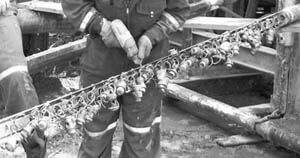Drilling to Total Depth (TD)
When total depth is achieved the operating company hopes that the hole will be productive. The formation of interest which is thought to contain hydrocarbons is penetrated by the hole at the final stage of drilling. At this point a big decision must be made. Does the well contain enough oil or gas to make running the final production string of casing worthwhile? Will it make economic sense to complet the well? Evaluation of the cuttings and further tests provide answers to these questions.
Evaluating Formations
Examining Cuttings
One of the most imediate ways of determining the makeup of a deep formation is to examine the cuttings from that depth. Cuttings are carried away from the bit by the mud compound back to the surface. A mud logger or geologist in addition to monitoring downhole conditions at the site will also catch cuttings at the flow ditch. Examination under a microscope or ultraviolet light can reveal the presence of oil in the cuttings. In addition a gas-detection instrument may be employed to determine the presence of natural gas.
Well Logging
A more advanced technique is well logging. Typically logging will be carried out by a company that specializes in logging. The logging company will be on site while the crew trips out the drill string. With a portable laboratory on board a truck the well loggers lower logging tools into the well suspended from wireline. The tools are lowered to the total depth of the well and are reeled back up slowly. It’s during this upward pass that the tool measures the properties of the formations surrounding the well bore. Electric logs measure and record natural and induced electricity in formations. Other types of logs use a form of sonar to ping the formations and measure and record the rebounding soundwave. Radioactivity logs measure and record the effects of natural and induced radiation on the formations. Since all of these logging tools make a record during the tool’s journey up the well a graph resembling an electrocardiogram or EKG is produced that can be studied and interpreted. Experienced engineers or geologists can identify signs of the existence of oil and gas and make estimations of how much may be present at any given depth. Recent advances have made the interpretation of logs easier through computer automation.
Coring
Formation core samples are sometimes taken to compliment the data gleaned from other tests. There are two primary methods of obtaining cores. One way is is the use of a core barrel whick is run to the bottom of the hole on the drill string. As the core barrel is rotated it cuts a cylindrical core a few inches in diameter that is received in a tube above the cutting bit. Each core taken by this method requires a complete round trip down and up the hole. The other method is sidewall sampling. Taking a sidewall core sample involves a series of small explosive charges that ram a small cylinder into the wall of the hole when fired. When the tool is pulled out of the hole the small core samples are brought up with the tool. Up to thirty cores can be taken at any desired depth. Whatever the method, core samples are examined in a laboratory and can reveal a great deal about the structure of formations at the well hole.



